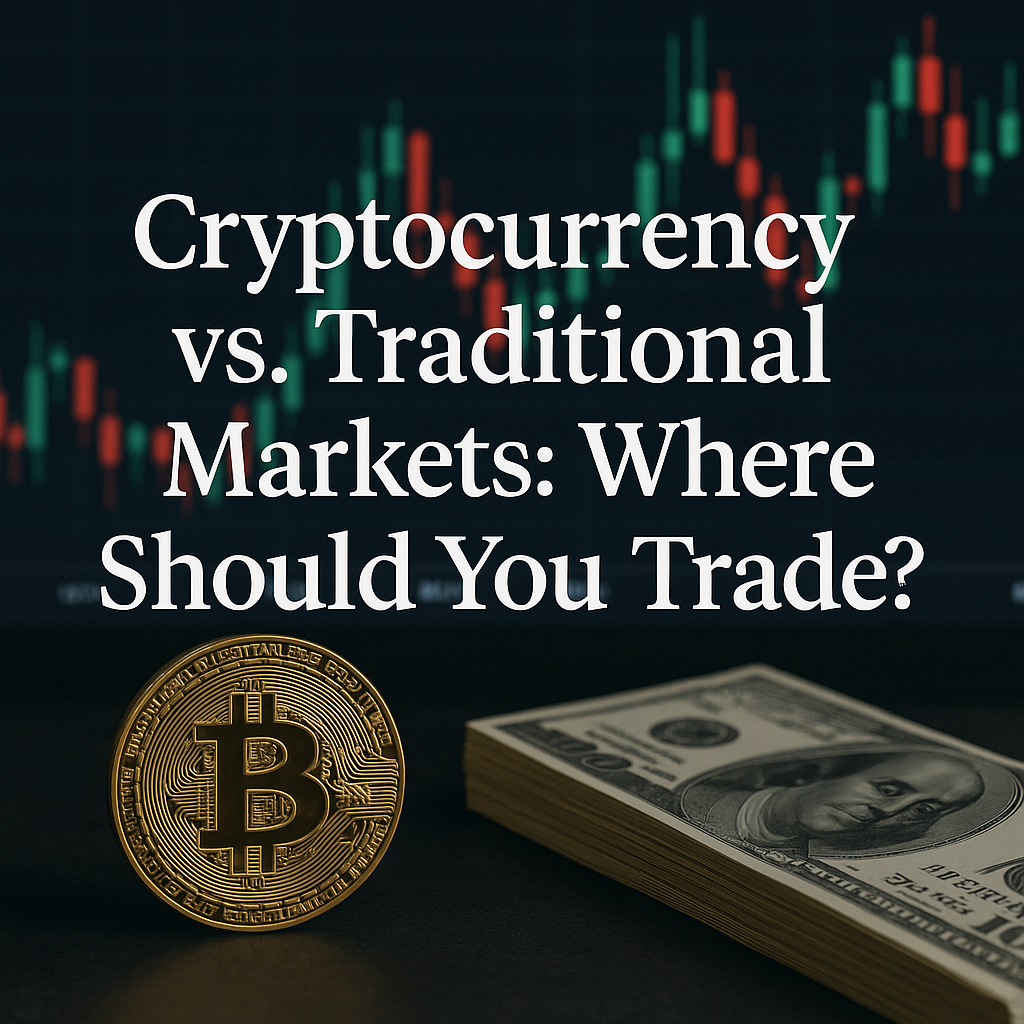Introduction: A Crossroads for Modern Traders
In recent years, the financial landscape has exploded with choice. Once dominated by equities, bonds, and forex, today’s market offers access to digital assets like Bitcoin, Ethereum, and countless altcoins — each promising rapid growth, decentralization, and innovation.
But for many traders — especially those just getting serious — a key question arises:
Should I focus on crypto, traditional markets, or both?
This post breaks down the major differences, similarities, and trade-offs between crypto and traditional asset classes to help you identify where your strengths align and which environment best suits your goals.
Volatility: Fuel or Fire?
Cryptocurrency:
Crypto markets are known for extreme volatility. A single tweet, protocol update, or regulatory rumour can send a coin soaring 50% or crashing overnight. While this presents opportunities for fast profits, it also introduces significant downside risk.
Traditional Markets:
Stocks, forex, and indices are generally more stable and structured. Volatility is often tied to macroeconomic data or corporate earnings, making movements easier to anticipate with fundamental and technical analysis.
Bottom Line:
- If you thrive in high-speed environments and can handle emotional swings, crypto may appeal to you.
- If you prefer more measured price action and data-backed setups, traditional markets offer a smoother experience.
Market Hours and Accessibility
Crypto:
The crypto market never sleeps — it operates 24/7, including weekends and holidays. This offers unmatched flexibility but can also lead to fatigue and inconsistent routines.
Traditional:
Most stock markets operate within set hours (e.g., 9:30–4:00 EST for the NYSE), with forex offering nearly 24-hour trading on weekdays. Set hours allow traders to plan and avoid overtrading.
Bottom Line:
- Crypto is ideal for those who want flexible schedules or live in time zones misaligned with major exchanges.
- Traditional markets may suit those who prefer fixed routines and rest periods between sessions.
Regulation and Safety
Cryptocurrency:
Still largely unregulated in many jurisdictions, crypto poses unique risks: exchange collapses, rug pulls, and wallet hacks. While transparency and decentralization are strengths, lack of oversight means traders must do more due diligence.
Traditional:
Stocks and forex are heavily regulated. Brokerages must adhere to strict compliance rules, and investor protections (like insurance and dispute resolution) are more robust.
Bottom Line:
- If you value transparency and security, traditional markets offer more protection.
- If you’re tech-savvy and willing to accept higher risk, crypto allows greater autonomy and innovation.
Tools, Strategies, and Data
Crypto:
Many traditional indicators (RSI, MACD, support/resistance) work in crypto, but market behavior is often less structured and more sentiment-driven. On-chain metrics, whale wallets, and social media sentiment play a larger role.
Traditional:
Technical and fundamental tools are mature and well-tested. Earnings reports, interest rate decisions, and macroeconomic data provide reliable signals for decision-making.
Bottom Line:
- Crypto requires adaptability and unconventional data sources.
- Traditional markets reward structured, data-informed strategies.
Liquidity and Slippage
Crypto:
While Bitcoin and Ethereum enjoy decent liquidity, many altcoins suffer from low volume, leading to significant slippage on larger orders.
Traditional:
Major stocks, ETFs, and forex pairs offer high liquidity, allowing for smoother execution and tighter spreads.
Bottom Line:
- Active intraday traders may find execution more efficient in traditional markets.
- Crypto traders must choose assets carefully and plan for slippage.
Psychology and Community
Crypto:
The crypto community is younger, more experimental, and often built around online subcultures. Memes, hype cycles, and FOMO are part of the game. Risk appetite is generally higher.
Traditional:
Traders in traditional markets often take a more conservative and institutional approach. Discipline, patience, and consistency are more heavily emphasized.
Bottom Line:
- Choose your trading environment based on your temperament and goals.
- Crypto fosters rapid innovation but also emotional turbulence.
- Traditional markets are more methodical and professionally oriented.
Final Thoughts: Where Should You Trade?
There’s no universal answer — only alignment.
Ask yourself:
- Do I want fast-paced, 24/7 action with cutting-edge assets? → Crypto may be for you.
- Do I prefer structure, proven strategies, and long-term consistency? → Traditional markets may suit you better.
Some traders successfully operate in both spaces — using crypto for short-term scalps or trend trades, while managing a long-term stock portfolio.
What matters most is understanding your edge, your time commitment, and your risk tolerance.
At Tokyo Traders
We support both crypto and traditional traders. Our community includes:
- Weekly cross-market strategy sessions
- Live chart breakdowns from multiple asset classes
- Peer accountability groups for crypto and equities
- Ongoing discussion about evolving regulations and tools
No matter what you trade — the key is to trade smart.
Would you like:
- A side-by-side downloadable comparison chart?
- Infographics showing average volatility or liquidity differences?
- Member polls on trading preference (crypto vs traditional)?
Let me know, and I’ll create them for you.


